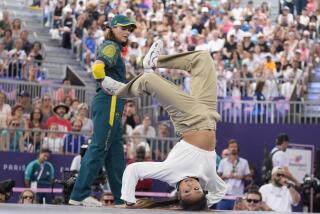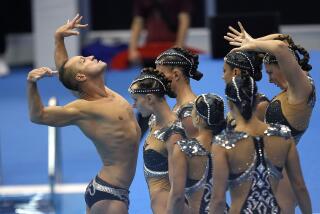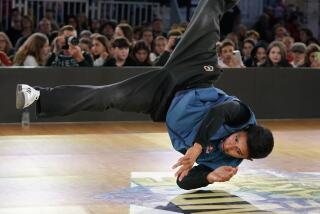This Guy Just May Well Be Unsinkable Synchro Man
UNIONDALE, N.Y. — As a columnist, it is my job to analyze as objectively and dispassionately as possible the most provocative issues in sports and then offer reasoned opinions.
Occasionally, however, I admit it’s possible my conclusions could be colored by biases entirely beyond my control. Gender would be one of them.
Take, for instance, the controversy at the Goodwill Games over whether Bill May of the Santa Clara Aquamaids should have been allowed to compete in the heretofore (with a couple of low-profile exceptions) all-female sport of synchronized swimming.
My answer is an unqualified, “You’re darn right he should have been!”
I am man. Hear me roar.
We have male police officers, male firefighters and male soldiers. In past times, California has even had male senators.
Why shouldn’t we have male synchro swimmers?
It’s not exactly a new concept.
Martin Short and Harry Shearer, destined to be remembered as the Betty Friedan and Gloria Steinem of the men’s synchronized swimming movement, ventured into uncharted waters in a 1984 “Saturday Night Live” skit inspired by the sport’s Olympic debut in Los Angeles.
“I remember, it was a Friday and my wife, Valerie, asked, ‘Honey, is there something wrong?’ ” Shearer said during the skit.
“And I said, ‘No, there’s nothing wrong. I’ve made a decision. I’m leaving the accounting firm, and Lawrence [Short] and I are going to pursue a dream that we have, that basically synchronized swimming is going to be our lives for the rest of the century.’ ”
They faced two major obstacles.
One was that Short couldn’t swim, practicing his routines in the shallow end of the pool while wearing a life preserver and swim cap.
The other was that men weren’t allowed to compete in Olympic synchronized swimming.
Fourteen years later, we still aren’t.
Bill May is here to change that.
May, who became interested in the sport when he was 10 and had to sit through his older sister’s synchro swimming practices, didn’t have to leave an accounting firm to pursue his dream. He is only 19.
But he, like a lot of figure skaters and gymnasts, did have to leave home, moving from Cicero, N.Y., where he competed for the Syracuse Synchro Cats and Oswego Lakettes, when he became accomplished enough to join the country’s most prestigious club, the Santa Clara Aquamaids.
He was accepted with open arms by the Aquamaids, especially by the two women with whom he was assigned to share an apartment, Kristina Lum and Carrie Barton. Like John Ritter in “Three’s Company,” May was easily the best cook.
“He makes truffles,” Lum said. “He really makes some great desserts. Me cook? No. Just pasta. Spaghetti.”
Aquamaid Coach Chris Carver said May has become such a popular member that, in deference to him, the club might change its name to Aqua Jets.
Some competitors, however, were not so accepting after May made history Monday at the Nassau County Goodwill Games Swimming & Diving Center, where he and Lum finished second in the duet competition.
As a result, May, the first man to become a member of his country’s synchronized swimming national team, also became the first man to win a medal in the sport at such a high level of competition. Later in the day, May won another silver medal as one of eight U.S. swimmers in the team competition.
Lum and May performed their free program to Ravel’s “Bolero,” admitting they were inspired by the passion and romance British ice dancers Jayne Torvill and Christopher Dean applied to the same music during the 1984 Winter Olympics.
It was not the kind of approach judges are prepared to see from two women swimming together, decidedly more erotic, let’s say, than the Holocaust routine that a French team tried to bring to the Atlanta Olympics.
But that is not the reason some women don’t want to compete against men.
“The physical strength is different,” said Miya Tachibana, a member of the Japanese duet that finished third Monday after winning silver medals at last year’s World Championships. “In some ways, it’s not fair.”
Carver countered that a man’s advantage in strength is offset by a woman’s advantage in grace and flexibility.
Even so, she suggested a compromise, that the international swimming federation adopt a mixed pairs event so men can compete in international events such as the Olympics and World Championships.
Lum, 21, of Fremont, Calif., is so devoted to that cause that she will forsake her chance to compete as a member of a duet in the 2000 Summer Olympics by refusing to seek a female partner.
“I’m sticking with Bill,” she said. “I want to do something really different and start something new in the sport.”
May called her commitment “really awesome.”
“We did this because we wanted to change synchronized swimming by utilizing the different skills of a man and women,” he said. “We want to kind of evolve the sport like ice skating has. I hope that seeing a man in the sport will encourage other men.”
Hear, hear.
It’s high time U.S. men reestablished themselves in international sports, what with 1996 becoming recognized as the “Year of the Woman” because of their successes in Atlanta. They also dominated this year in Nagano with Tara Lipinski, Michelle Kwan, Picabo Street and the hockey team.
Don’t look for them to let up next year, when the U.S. women’s soccer team plays host to the women’s World Cup. Mia Hamm, Kristine Lilly, Julie Foudy and teammates can establish themselves as solid favorites by winning the Goodwill Games tournament here next week.
With improvement, maybe some male U.S. soccer players could become good enough to play with them.
More to Read
Go beyond the scoreboard
Get the latest on L.A.'s teams in the daily Sports Report newsletter.
You may occasionally receive promotional content from the Los Angeles Times.






